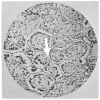Overview on the Different Patterns of Tumor Vascularization
- PMID: 33805699
- PMCID: PMC8000806
- DOI: 10.3390/cells10030639
Overview on the Different Patterns of Tumor Vascularization
Abstract
Angiogenesis is a crucial event in the physiological processes of embryogenesis and wound healing. During malignant transformation, dysregulation of angiogenesis leads to the formation of a vascular network of tumor-associated capillaries promoting survival and proliferation of the tumor cells. Starting with the hypothesis formulated by Judah Folkman that tumor growth is angiogenesis-dependent, this area of research has a solid scientific foundation and inhibition of angiogenesis is a major area of therapeutic development for the treatment of cancer. Over this period numerous authors published data of vascularization of tumors, which attributed the cause of neo-vascularization to various factors including inflammation, release of angiogenic cytokines, vasodilatation, and increased tumor metabolism. More recently, it has been demonstrated that tumor vasculature is not necessarily derived by endothelial cell proliferation and sprouting of new capillaries, but alternative vascularization mechanisms have been described, namely vascular co-option and vasculogenic mimicry. In this article, we have analyzed the mechanisms involved in tumor vascularization in association with classical angiogenesis, including post-natal vasculogenesis, intussusceptive microvascular growth, vascular co-option, and vasculogenic mimicry. We have also discussed the role of these alternative mechanism in resistance to anti-angiogenic therapy and potential therapeutic approaches to overcome resistance.
Keywords: angiogenesis; tumor growth; vascular co-option; vasculogenic mimicry.
Conflict of interest statement
The authors declare no conflict of interest.
Figures




References
-
- Hall A.P. The role of angiogenesis in cancer. Comp. Clin. Pathol. 2005;13:95–99. doi: 10.1007/s00580-004-0533-3. - DOI
-
- Hunter J., Owen R. Essays and Observations on Natural History, Anatomy, Physiology, Psychology, and Geology. John van Voorst; London, UK: 1861. - DOI
-
- Flint J.M. The angiology, angiogenesis, and organogenesis of the submaxillary gland. Am. J. Anat. 1903;2:417–444. doi: 10.1002/aja.1000020402. - DOI
Publication types
MeSH terms
LinkOut - more resources
Full Text Sources
Other Literature Sources
Medical

